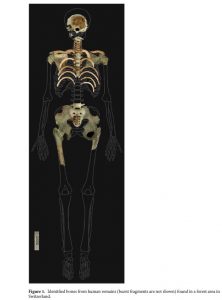Typically, TV forensic shows, such as CSI and Bones, portray how forensic cases are fast and easy to solve within a couple of episodes. However, that is not true. Unlike in forensic shows, forensic cases take a long time to solve in real life, due to challenges that investigators have to face.
One of the challenges that criminal investigators have to solve is to determine the post-mortem interval (PMI) from decomposed skeletons. Post-mortem interval is the time after someone has died, which is important when the cause of death is unknown. Usually, medical assessment of corpses can determine the PMI after the body is dead for the first few days. However, when the victim’s bones and hairs are found after a few years, the accuracy of the PMI lowers. Therefore, new method is required to provide a more accurate estimation of the extended time of death.
Currently, there are numerous studies that use different methods for solving the PMI. Many methods include analyzing soil chemistry and insects at the crime scene. Since these methods could be complementary to each other, the scientists in Switzerland believe that combining these methods would improve the long-term PMI estimate, while illustrating how the crime scene could have occurred. Therefore, the Swiss scientists have attempted to use five different approaches simultaneously to estimate the PMI of the bone and hair remains. Once the soil, bone, and hair samples are collected from the Swiss forest, the scientists use five different approaches for analyses, which include using radiocarbon dating, analyzing pH and soil chemistry, counting and classifying nematodes and mites, and sequencing DNA of soil micro-eukaryotes.

An example of a forest. Martin Abegglen,Creative Commons Attribution-Share Alike 2.0 Generic license, Forest
After analyzing the findings, the scientists are able to propose a possible PMI, as well as the crime scene. First of all, the radiocarbon dating determines that the bones belong to a young adult male. Secondly, chemical, nematodes, and micro-eukaryotic analyses suggest that the remains have been partly decomposed in the forest for at least 8-9 months. Finally, the evidence from mites suggests that the corpse is partly decomposed in a separate confined place, because these mite species are only found in confined environment. Therefore, the suspect(s) could have allowed the corpse to decompose in a confined area before relocating it to the Swiss forest. As a result, the PMI of the dead victim appears to be at least 8-12 months before the body is discovered.

The skeleton that is found in a Swiss forest. Ildikó Szelecz, Sandra Lösch, Christophe V. W. Seppey, Enrique Lara, David Singer, Franziska Sorge1, Joelle Tschui, M. Alejandra Perotti & Edward A. D. Mitchell, Source, Creative Commons Attribution 4.0 International Licence
Overall, the study shows that using five approaches simultaneously in a forensic case study can estimate the PMI, while illustrating a possible crime scene of how the victim could have died. Moreover, all of the approaches can be complementary with each other, in order to provide more evidence from scarce remains. In conclusion, it is possible to further develop this technique in order to estimate PMI in other forensic cases.
Update: Blog post has been revised on 2019, Feb 15th.
Reference
Rasmussen College. How Accurate are Crime Shows on TV? Debunking 7 Common Myths. https://www.rasmussen.edu/degrees/justice-studies/blog/crime-show-myths-debunked-forensic-experts-tell-what-life-is-real/
Keele University. Chemical Ecology. PMI in Forensic Entomology. https://www.keele.ac.uk/chemicalecology/projects/pmi/
American Council on Science and Health. How Chemistry, Microbiology Could Help Catch A Killer. https://www.acsh.org/news/2018/01/18/how-chemistry-microbiology-could-help-catch-killer-12422 .
Szelecz, I.; Lösch, S.; Seppey, C. V. W.; Lara, E.; Singer, D.; Sorge, F.; . . . Mitchell, E. A. D. . Comparative analysis of bones, mites, soil chemistry, nematodes and soil micro-eukaryotes from a suspected homicide to estimate the post-mortem interval. Scientific Reports. [Online] 2018, 8(1), 25. doi:10.1038/s41598-017-18179-z.
